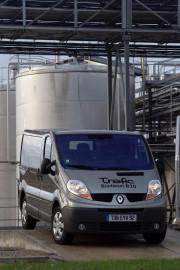|
| |||||
|
Renault prepares to develop a mobility solution using electricity
| ||||
|
As part of "Renault Commitment 2009", the company is pursuing an ambitious
plan to reduce emissions. This plan is based on three commitments: to be one
of the world’s top three car makers for low level emissions of CO2, to offer
a range of models powered by biofuels such as bioethanol and biodiesel and to
develop a wide range of technologies, including electric power, that are
affordable for customers. One initiative which Renault is working on is a mobility solution using
electric energy that will eliminate CO2 emissions when the vehicle is in
motion. This technology is being jointly developed with Nissan as part of the
Alliance. A vehicle application is expected in 2010. Renault has firmly committed to cutting its vehicles’ CO2 emissions
significantly in order to help reduce the so-called greenhouse effect. Plan
"120/140" has a precise target for 2008: to sell one million vehicles emitting
less than 140 g of CO2/km, with one third emitting less than 120 g. Renault is
working on a range of alternative technologies that are financially affordable
for customers and can be extensively distributed. One of these alternative
technologies is a mobility solution that uses electric energy. An electric mobility solution by 2010 As part of the research underway in cooperation with Nissan, Renault is
looking into a solution that is ideally suited to city driving and does not
emit any CO2 at all when the vehicle is in motion. The project has reached
an advanced stage and Renault is already working on all the future vehicle's
components. Renault and Nissan are working together on Lithium-Ion battery
technology and packaging, the electric motor and the software that is needed
to manage the solution. Work is also underway on a process to recover energy
when the vehicle brakes. The close fit between the Alliance's different markets offers the
potential for the high sales volumes that are needed for the project to be
economically viable. Renault will focus mainly on the fleet market in France
and throughout the wider European market in 2010. A range of affordable technologies that can be extensively distributed Technologies based on electricity represent just one of the solutions being
developed by Renault in an effort to limit CO2 emissions and combat any potential
global warming. Other solutions include the optimisation of conventional engines,
as demonstrated by Renault's downsizing strategy that consists in reducing cubic
capacity, while maintaining equivalent performance. This strategy remains one of
the most cost effective means of reducing gas emissions. The latest petrol engine, the 100 hp TCE, is a perfect example of the vast
expertise that Renault has accumulated in this area. Delivering the 100 hp output
of a 1.4-litre engine and the 145 Nm of torque characteristic of a 1.6-litre engine,
this 1.2-litre powerplant enables Modus and Clio to achieve combined cycle fuel
consumption of 5.9 litres/100 kms, representing just 140 g/km of CO2 emissions.
Renault displays the same degree of expertise when it comes to diesel engines. In
1993 a 93 hp 1.9DT Renault 19 could cover the 748 kms between Paris and Montpellier
with an average fuel consumption of 6.5 litres/100 km, representing CO2 emissions
of 172 g/km. By 2000, a 1.9 dTi 100 hp Megane could drive its occupants the 960 kms
from Paris to Monaco with a fuel consumption of 5.2 litres/100 kms, equivalent to CO2
emissions of 138 g/km. A full tank will today take a 1.5 dCi 105 hp Megane all the
way from Paris to Venice – a distance of 1,110 kms – with fuel consumption of just 4.5
litres/100kms and CO2 emissions of 120 g/km. The CO2 emissions generated by equivalent
models have been reduced by 30%. In 2005, more than 100,000 Megane 1.5 dCi models, emitting just 120 g/km of CO2,
were sold in Europe. In the same year, almost one Renault vehicle sold in Europe in
five emitted less than 120 g/km of CO2. Renault has also committed to offering a complete range of vehicles by 2009 that
run on biofuels at a price that is comparable with that of petrol- and diesel-driven
models. By that time, 50% of petrol-driven vehicles on sale in Europe will also be
able to use bioethanol and every diesel engine will be capable of running on fuel
containing 30% of biodiesel. In keeping with this target, in 2007 Renault will be
one of the few car makers to offer its European customers a double biofuel deal.
Trafic and Master are already available with B30 biodiesel-compatible engines and,
in (northern) spring 2007, a 1.6-litre 16v 110 hp version of Megane will be launched
with an E85 bioethanol-compatible powerplant. Renault considers biofuels to be one of
the most efficient and economical solutions for curbing CO2 emissions in the mid-term,
because they can be easily applied to mass produced vehicles. In the "well-to-wheel"
approach, the overall performance of biofuels is superior to that of traditional
fuels. Depending on the vegetable material used to produce them, some biofuels can
reduce CO2 emissions by up to 70% in comparison with a petrol engine. Since they are
produced from vegetable matter and biomass, biofuels are a renewable, diversified
energy source that will help limit our dependence on fossil fuels. In the longer term, the Renault-Nissan Alliance is also developing hybrid vehicles
and fuel cell technologies. | |||||
ABN 47106248033 |
 |
All rights reserved. |
